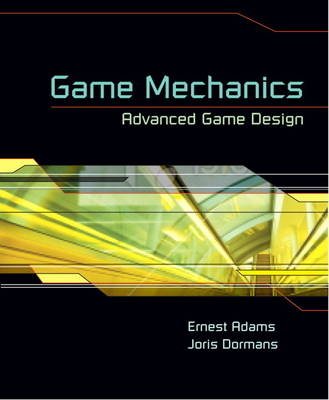
Game Mechanics
New Riders Publishing (Verlag)
978-0-321-82027-3 (ISBN)
- Titel ist leider vergriffen;
keine Neuauflage - Artikel merken
In Game Mechanics: Advanced Game Design, you’ll learn how to:
* Design and balance game mechanics to create emergent gameplay before you write a single line of code.
* Visualize the internal economy so that you can immediately see what goes on in a complex game.
* Use novel prototyping techniques that let you simulate games and collect vast quantities of gameplay data on the first day of development.
* Apply design patterns for game mechanics—from a library in this book—to improve your game designs.
* Explore the delicate balance between game mechanics and level design to create compelling, long-lasting game experiences.
* Replace fixed, scripted events in your game with dynamic progression systems to give your players a new experience every time they play.
"I've been waiting for a book like this for ten years: packed with game design goodness that tackles the science without undermining the art."
--Richard Bartle, University of Essex, co-author of the first MMORPG
“Game Mechanics: Advanced Game Design by Joris Dormans & Ernest Adams formalizes game grammar quite well. Not sure I need to write a next book now!”
-- Raph Koster, author of A Theory of Fun for Game Design.
Ernest Adams is a game design consultant, teacher, and the author of the classic Fundamentals of Game Design, Second Edition, the companion volume to this title. He has worked in the game industry for 23 years, eight of them at Electronic Arts. He is also the founder and first chairman of the International Game Developers’ Association. His professional web site is at www.designersnotebook.com. Joris Dormans (PhD) is a game design lecturer and researcher based in Amsterdam with eight years of experience in higher education. For the past four years he has been researching formal tools and methods to design game mechanics. As an independent, freelance game designer he published and worked on several video games and board games, including story-driven adventure games, physical platform games, and a satirical political card game. His professional web site is at www.jorisdormans.nl.
Introduction
Who Is This Book For?
How Is This Book Organized?
Companion Website.
Chapter 1
Designing Game Mechanics
Rules Define Games
Discrete Mechanics vs. Continuous Mechanics
Mechanics and the Game Design Process
Prototyping Techniques
Summary
Exercises
Chapter 2
Emergence and Progression
The History of Emergence and Progression
Comparing Emergence and Progression
Games of Emergence
Games of Progression
Structural Differences
Emergence and Progression Integration
Summary
Exercise
Chapter 3
Complex Systems and the Structure
of Emergence
Gameplay as an Emergent Property of Games
Structural Qualities of Complex Systems
Harnessing Emergence in Games
Summary
Exercises
Chapter 4
Internal Economy
Elements of Internal Economies
Economic Structure
Uses for Internal Economies in Games
Summary
Exercises
Chapter 5
Machinations
The Machinations Framework
Machinations Diagram Basic Elements
Advanced Node Types
Modeling Pac-Man
Summary
Exercises
Chapter 6
Common Mechanisms
More Machinations Concepts
Feedback Structures in Games
Randomness vs. Emergence
Example Mechanics
Summary
Exercises
Chapter 7
Design Patterns
Introducing Design Patterns
Machinations Design Pattern Language
Leveraging Patterns for Design
Summary
Exercises
Chapter 8
Simulating and Balancing Games
Simulated Play Tests
Playing with Monopoly
Balancing SimWar
From Model to Game
Summary
Exercises
Chapter 9
Building Economies
Economy-Building Games
Analyzing Caesar III
Designing Lunar Colony
Summary
Exercises
Chapter 10
Integrating Level Design and Mechanics
From Toys to Playgrounds
Missions and Game Spaces
Learning to Play
Summary
Exercises
Chapter 11
Progression Mechanisms
Lock-and-Key Mechanisms
Emergent Progression
Summary
Exercises
Chapter 12
Meaningful Mechanics
Serious Games
Communication Theory
The Semiotics of Games and Simulations
Multiple Layers of Meaning
Summary
Exercises
Appendix A
Machinations Quick Reference
Appendix B
Design Pattern Library
Static Engine
Dynamic Engine
Converter Engine
Engine Building
Static Friction
Dynamic Friction
Stopping Mechanism
Attrition
Escalating Challenge
Escalating Complexity
Arms Race
Playing Style Reinforcement
Multiple Feedback
Trade
Worker Placement
Slow Cycle
Appendix C
Getting Started with Machinations
References
Index
| Erscheint lt. Verlag | 5.7.2012 |
|---|---|
| Reihe/Serie | Voices That Matter |
| Sprache | englisch |
| Maße | 188 x 231 mm |
| Gewicht | 720 g |
| Themenwelt | Informatik ► Software Entwicklung ► Spieleprogrammierung |
| Informatik ► Weitere Themen ► Computerspiele | |
| ISBN-10 | 0-321-82027-4 / 0321820274 |
| ISBN-13 | 978-0-321-82027-3 / 9780321820273 |
| Zustand | Neuware |
| Haben Sie eine Frage zum Produkt? |
aus dem Bereich


